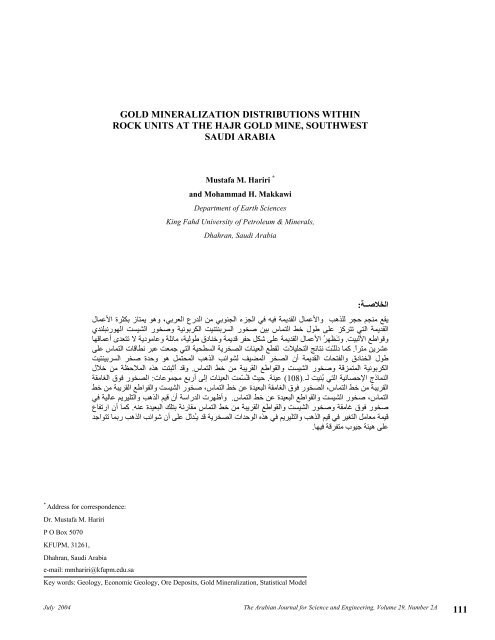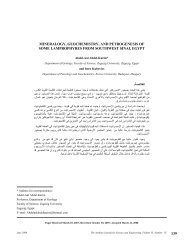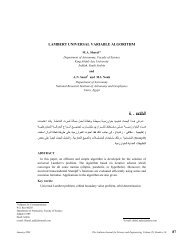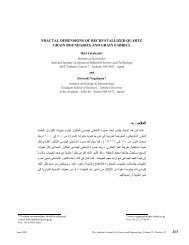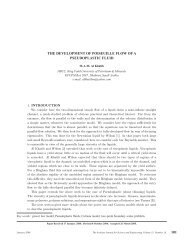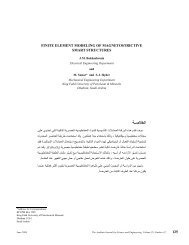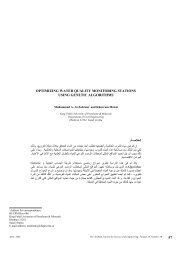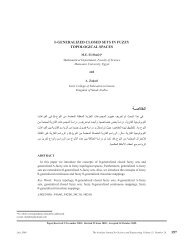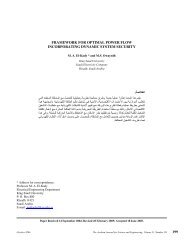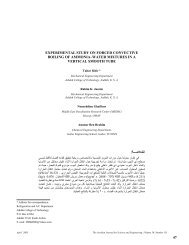111 gold mineralization distributions within rock units at the hajr gold ...
111 gold mineralization distributions within rock units at the hajr gold ...
111 gold mineralization distributions within rock units at the hajr gold ...
You also want an ePaper? Increase the reach of your titles
YUMPU automatically turns print PDFs into web optimized ePapers that Google loves.
Mustafa M. Hariri and Mohammad H. Makkawi<br />
GOLD MINERALIZATION DISTRIBUTIONS WITHIN<br />
ROCK UNITS AT THE HAJR GOLD MINE, SOUTHWEST<br />
SAUDI ARABIA<br />
Mustafa M. Hariri *<br />
and Mohammad H. Makkawi<br />
Department of Earth Sciences<br />
King Fahd University of Petroleum & Minerals,<br />
Dhahran, Saudi Arabia<br />
: ﺔــﺻﻼﺨﻟا<br />
لﺎﻤﻋﻷا ةﺮﺜﻜﺑ زﺎﺘﻤﻳ ﻮهو<br />
،ﻲﺑﺮﻌﻟا<br />
عرﺪﻟا ﻦﻣ ﻲﺑﻮﻨﺠﻟا ءﺰﺠﻟا ﻲﻓ ﻪﻴﻓ ﺔﻤﻳﺪﻘﻟا لﺎﻤﻋﻷاو ﺐهﺬﻠﻟ ﺮﺠﺣ ﻢﺠﻨﻣ ﻊﻘﻳ<br />
يﺪﻨﻠﺒﻧرﻮﻬﻟا ﺖﺴﻴﺸﻟا رﻮﺨﺻو ﺔﻴﻧﻮﺑﺮﻜﻟا ﺖﻴﻨﺘﻨﺑﺮﺴﻟا رﻮﺨﺻ ﻦﻴﺑ سﺎﻤﺘﻟا ﻂﺧ لﻮﻃ ﻰﻠﻋ ﺰآﺮﺘﺗ ﻲﺘﻟا ﺔﻤﻳﺪﻘﻟا<br />
ﺎﻬﻗﺎﻤﻋأ ىﺪﻌﺘﺗ ﻻ ﺔﻳدﻮﻣﺎﻋو ﺔﻠﺋﺎﻣ ،ﺔﻴﻟﻮﻃ قدﺎﻨﺧو<br />
ﺔﻤﻳﺪﻗ ﺮﻔﺣ ﻞﻜﺷ ﻰﻠﻋ ﺔﻤﻳﺪﻘﻟا لﺎﻤﻋﻷا ُﺮﻬﻈ َـﺗو<br />
. ﺖﻴﺒﻟﻷا ﻊﻃاﻮﻗو<br />
ﻰﻠﻋ سﺎﻤﺘﻟا تﺎﻗﺎﻄﻧ ﺮﺒﻋ ﺖﻌﻤﺟ ﻲﺘﻟا ﺔﻴﺤﻄﺴﻟا ﺔﻳﺮﺨﺼﻟا تﺎﻨﻴﻌﻟا ﻊﻄﻘﻟ تﻼﻴﻠﺤﺘﻟا ﺞﺋﺎﺘﻧ ﺖّـﻠﻟد<br />
ﺎﻤآ . ًاﺮﺘﻣ ﻦﻳﺮﺸﻋ<br />
ﺖﻴﺘﻨﻴﺑﺮﺴﻟا ﺮﺨﺻ ةﺪﺣو ﻮه ﻞﻤﺘﺤﻤﻟا ﺐهﺬﻟا ﺐﺋاﻮﺸﻟ ﻒﻴﻀﻤﻟا ﺮﺨﺼﻟا نأ ﺔﻤﻳﺪﻘﻟا تﺎﺤﺘﻔﻟاو قدﺎﻨﺨﻟا لﻮﻃ<br />
لﻼﺧ ﻦﻣ ﺔﻈﺣﻼﻤﻟا ﻩﺬه ﺖﺘﺒﺛُا<br />
ﺪﻗو . سﺎﻤﺘﻟا ﻂﺧ ﻦﻣ ﺔﺒﻳﺮﻘﻟا ﻊﻃاﻮﻘﻟاو ﺖﺴﻴﺸﻟا رﻮﺨﺻو ﺔﻗﺰﻤﺘﻤﻟا ﺔﻴﻧﻮﺑﺮﻜﻟا<br />
ﺔﻘﻣﺎﻐﻟا قﻮﻓ رﻮﺨﺼﻟا : تﺎﻋﻮﻤﺠﻣ ﻊﺑرأ ﻰﻟإ تﺎﻨﻴﻌﻟا ﺖﻤّﺴُـﻗ<br />
ﺚﻴﺣ . ﺔﻨﻴﻋ<br />
( 108)<br />
ِ ـﻟ<br />
ﺖﻴﻨُﺑ<br />
ﻲﺘﻟا ﺔﻴﺋﺎﺼﺣﻹا جذﺎﻤﻨﻟا<br />
ﻂﺧ ﻦﻣ ﺔﺒﻳﺮﻘﻟا ﻊﻃاﻮﻘﻟاو<br />
ﺖﺴﻴﺸﻟا رﻮﺨﺻ ،سﺎﻤﺘﻟا<br />
ﻂﺧ ﻦﻋ ةﺪﻴﻌﺒﻟا ﺔﻘﻣﺎﻐﻟا قﻮﻓ رﻮﺨﺼﻟا ،سﺎﻤﺘﻟا ﻂﺧ ﻦﻣ ﺔﺒﻳﺮﻘﻟا<br />
ﻲﻓ ﺔﻴﻟﺎﻋ ﻢﻳﺮﻴﻠﺘﻟاو ﺐهﺬﻟا ﻢﻴﻗ نأ ﺔﺳارﺪﻟا تﺮﻬﻇأو . سﺎﻤﺘﻟا ﻂﺧ ﻦﻋ ةﺪﻴﻌﺒﻟا ﻊﻃاﻮﻘﻟاو ﺖﺴﻴﺸﻟا رﻮﺨﺻ ،سﺎﻤﺘﻟا<br />
عﺎﻔﺗرا نأ ﺎﻤآ . ﻪﻨﻋ ةﺪﻴﻌﺒﻟا ﻚﻠﺘﺑ ﺔﻧرﺎﻘﻣ سﺎﻤﺘﻟا ﻂﺧ ﻦﻣ ﺔﺒﻳﺮﻘﻟا ﻊﻃاﻮﻘﻟاو ﺖﺴﻴﺸﻟا رﻮﺨﺻو ﺔﻘﻣﺎﻏ قﻮﻓ رﻮﺨﺻ<br />
ﺪﺟاﻮﺘﺗ<br />
ﺎﻤﺑر ﺐهﺬﻟا ﺐﺋاﻮﺷ نأ ﻰﻠﻋ ﻞﻟﺪُـﻳ<br />
ﺪﻗ ﺔﻳﺮﺨﺼﻟا تاﺪﺣﻮﻟا ﻩﺬه ﻲﻓ ﻢﻳﺮﻴﻠﺘﻟاو ﺐهﺬﻟا ﻢﻴﻗ ﻲﻓ ﺮﻴﻐﺘﻟا ﻞﻣﺎﻌﻣ ﺔﻤﻴﻗ<br />
. ﺎﻬﻴﻓ ﺔﻗﺮﻔﺘﻣ<br />
بﻮﻴﺟ ﺔﺌﻴه<br />
ﻰﻠﻋ<br />
*<br />
Address for correspondence:<br />
Dr. Mustafa M. Hariri<br />
P O Box 5070<br />
KFUPM, 31261,<br />
Dhahran, Saudi Arabia<br />
e-mail: mmhariri@kfupm.edu.sa<br />
Key words: Geology, Economic Geology, Ore Deposits, Gold Mineraliz<strong>at</strong>ion, St<strong>at</strong>istical Model<br />
July 2004 The Arabian Journal for Science and Engineering, Volume 29, Number 2A<br />
<strong>111</strong>
112<br />
Mustafa M. Hariri and Mohammad H. Makkawi<br />
ABSTRACT<br />
The Hajr <strong>gold</strong> mine <strong>within</strong> its ancient workings is loc<strong>at</strong>ed in <strong>the</strong> sou<strong>the</strong>rn<br />
part of <strong>the</strong> Arabian Shield. It is characterized by intensive ancient workings th<strong>at</strong><br />
are concentr<strong>at</strong>ed along <strong>the</strong> contact zones between <strong>the</strong> carbon<strong>at</strong>ized-serpentinite<br />
and <strong>the</strong> hornblende schist and <strong>the</strong> aplite dikes. The ancient workings are in <strong>the</strong><br />
form of open pits, linear trenches, and inclined and vertical shafts not exceeding<br />
20 meters depth. The analytical results for <strong>the</strong> surface chip samples, collected<br />
across <strong>the</strong> contact zones, and along <strong>the</strong> ancient shafts, trenches, and pit, indic<strong>at</strong>e<br />
th<strong>at</strong> <strong>the</strong> probable host <strong>rock</strong> for <strong>the</strong> <strong>gold</strong> <strong>mineraliz<strong>at</strong>ion</strong> is <strong>the</strong> sheared<br />
carbon<strong>at</strong>ized-serpentinite unit <strong>at</strong> its close contact with <strong>the</strong> schist and dike <strong>rock</strong><br />
<strong>units</strong>. This observ<strong>at</strong>ion is also proved through <strong>the</strong> st<strong>at</strong>istical evalu<strong>at</strong>ion based on<br />
<strong>the</strong> analysis of 108 samples. The samples were divided into four c<strong>at</strong>egories:<br />
ultramafic <strong>rock</strong>s away from contact (UAC), ultramafic <strong>rock</strong>s close to contact<br />
(UCC), schist and dike <strong>rock</strong>s close to contact (SCC), and schist <strong>rock</strong> <strong>units</strong> away<br />
from contact (SAC). The Au and Te values are higher <strong>within</strong> <strong>the</strong> UCC and SCC<br />
<strong>rock</strong> <strong>units</strong> compared to <strong>the</strong> UAC and SAC <strong>units</strong>. The high coefficient of vari<strong>at</strong>ion<br />
for <strong>gold</strong> and tellurium values in <strong>the</strong> former two <strong>rock</strong> <strong>units</strong> may also indic<strong>at</strong>e th<strong>at</strong><br />
<strong>gold</strong> <strong>mineraliz<strong>at</strong>ion</strong> might be present in several separ<strong>at</strong>ed pockets in both zones.<br />
The Arabian Journal for Science and Engineering, Volume 29, Number 2A July 2004
Mustafa M. Hariri and Mohammad H. Makkawi<br />
GOLD MINERALIZATION DISTRIBUTIONS WITHIN ROCK UNITS AT THE HAJR<br />
GOLD MINE, SOUTHWEST SAUDI ARABIA<br />
INTRODUCTION<br />
The ancient Hajr <strong>gold</strong> mine is loc<strong>at</strong>ed south of Bishah city <strong>at</strong> about 20 km sou<strong>the</strong>ast of <strong>the</strong> village of Hamdah <strong>at</strong><br />
l<strong>at</strong>itude 18º 52´ to 18º 57´ N; longitude 43º 34´ to 43º 53´ E (Figure 1). This mine is one of four mines named as <strong>the</strong><br />
Hajrah–Hamdah group of ancient mines [1]. The area is known <strong>at</strong> present as Hamdah <strong>gold</strong> deposit [2].<br />
24<br />
RED SEA<br />
0 400 km<br />
41<br />
Arabian Shield<br />
JEDDAH<br />
Arabian Gulf<br />
Hajr Mine<br />
Figure 1. Loc<strong>at</strong>ion map of Hajr mine (Modified after Collenette and Grainger [6]).<br />
Part of this study was conducted as part of <strong>the</strong> <strong>gold</strong> explor<strong>at</strong>ion project of <strong>the</strong> DMMR (Deputy Ministry for Mineral<br />
Resources). The objective of this study is to evalu<strong>at</strong>e <strong>the</strong> potential of <strong>gold</strong> <strong>mineraliz<strong>at</strong>ion</strong> in <strong>the</strong> Hajr mine and to<br />
determine <strong>the</strong> possible host <strong>rock</strong>s for <strong>gold</strong>. The field study included geological mapping and description of old mining<br />
July 2004 The Arabian Journal for Science and Engineering, Volume 29, Number 2A<br />
113
114<br />
Mustafa M. Hariri and Mohammad H. Makkawi<br />
works and <strong>rock</strong>-chip sampling for possible host <strong>rock</strong> <strong>units</strong>. Following chemical analyses of <strong>the</strong> <strong>rock</strong> samples, st<strong>at</strong>istical<br />
models for <strong>gold</strong> and tellurium distribution in <strong>the</strong> different <strong>rock</strong> <strong>units</strong> were constructed.<br />
GEOLOGICAL SETTING<br />
The <strong>rock</strong> <strong>units</strong> <strong>at</strong> Hajrah–Hamdah area have been classified into layered metamorphic <strong>rock</strong> <strong>units</strong>, serpentinite, and<br />
intrusive <strong>rock</strong>s [1,3]. The layered metamorphic <strong>rock</strong> <strong>units</strong> consist of quartz–biotite schist, a hornblende schist, a<br />
carbonaceous schist, and a chlorite–epidote schist of metavolcanic and metasedimentary origin. These <strong>rock</strong> <strong>units</strong><br />
represent Malahah subgroup of <strong>the</strong> Halaban greenstone belt [2]. A slab of deformed serpentinite overlies <strong>the</strong> hornblende<br />
schist, quartz–biotite schist, and carbonaceous schist and underlies <strong>the</strong> chloride–epidote schists [3,2]. The layered<br />
metamorphic <strong>rock</strong>s and serpentinite were intruded by diorite to granite, and mafic to felsic dikes and sills. At <strong>the</strong> Hajr<br />
mine area, <strong>rock</strong> <strong>units</strong> present are mainly hornblende schist, serpentinite, and felsic dike and sills [1] (Figure 2). The<br />
hornblende schist is fine-to medium grained and composed mainly of hornblende and plagioclase with minor epidote,<br />
actinolite, and chlorite. This schist unit is probably <strong>the</strong> metamorphosed equivalent of crystal lithic tuffs [1]. Intercal<strong>at</strong>ion<br />
of quartz–biotite schist and dark gray marble is also common.<br />
Waste m<strong>at</strong>erial from ancient mining<br />
Qu<strong>at</strong>ernary alluvium<br />
Serpentinite<br />
Hornblende schist<br />
0 200 m<br />
Faults<br />
Ancient workings<br />
Figure 2. Simplified geologic map of Hajr mine (modified after Helaby and Worl [1])<br />
Serpentinite conformably overlies <strong>the</strong> hornblende schist and <strong>the</strong> lower contact of <strong>the</strong> serpentinite parallels <strong>the</strong><br />
schistosity. Helaby and Worl [1] reported th<strong>at</strong> in many places <strong>the</strong> contact between <strong>the</strong> serpentinite and <strong>the</strong> hornblende<br />
schist is grad<strong>at</strong>ional. However field observ<strong>at</strong>ion and detailed mapping along and across <strong>the</strong> contact proved th<strong>at</strong> sharp<br />
contact is present all over <strong>the</strong> study area between <strong>the</strong> serpintenite and schist and aplite dike <strong>rock</strong> <strong>units</strong> (Figures 2 and 3).<br />
This contact, for most part, is gently dipping, and is intruded in many places by aplite and quartz vein and stringers. Worl<br />
[3] suggested th<strong>at</strong> <strong>the</strong> serpentinite may have origin<strong>at</strong>ed as a cumul<strong>at</strong>e complex of peridotite with minor pyroxenite.<br />
Bookstrom and o<strong>the</strong>rs [2] indic<strong>at</strong>ed th<strong>at</strong> <strong>the</strong> serpentinite may represent <strong>the</strong> erosional remnants of folded slab of Hamdah<br />
serpentinite th<strong>at</strong> was thrusted along <strong>the</strong> Hamdah thrust over <strong>the</strong> layered metamorphic <strong>rock</strong>s. Johnson [4] suggested th<strong>at</strong><br />
<strong>the</strong> serpentinite and pyroxenite <strong>within</strong> Asir terrane intruded in <strong>the</strong> period between about 810 and 740 Ma. The<br />
serpentinite is sheared and altered to asbestiform minerals, magnesite, calcite, and magnetite, and commonly<br />
The Arabian Journal for Science and Engineering, Volume 29, Number 2A July 2004<br />
N
Mustafa M. Hariri and Mohammad H. Makkawi<br />
carbon<strong>at</strong>ized and silicified along fractures and contacts. The serpentinite <strong>rock</strong> unit is altered to listwaenite in <strong>the</strong> upper<br />
part of <strong>the</strong> thrust zone and phyllonite in <strong>the</strong> lower part [2].<br />
0<br />
2M<br />
July 2004 The Arabian Journal for Science and Engineering, Volume 29, Number 2A<br />
N<br />
Dump m<strong>at</strong>erial<br />
Aplite dike<br />
Serpentinite<br />
Hornblende schist<br />
Open Pit<br />
Line of chip samples<br />
collection p<strong>at</strong>h<br />
Figure 3. Sketch of plan view of an ancient pit in Hajr mine area, showing <strong>the</strong> different <strong>rock</strong> <strong>units</strong> <strong>at</strong> <strong>the</strong> contact zone and <strong>the</strong><br />
sampling trace (modified after Hariri [5]).<br />
Aplite bodies occur as sills and dikes mainly along <strong>the</strong> contacts between <strong>the</strong> serpentinite and hornblende schist. In<br />
places <strong>the</strong>se <strong>rock</strong>s cut <strong>the</strong> hornblende schist. The aplite <strong>rock</strong>s are fine-grained, pinkish to yellowish, and composed<br />
mainly of quartz and feldspar with abundant garnet. They are similar in mineralogy to <strong>the</strong> plutons existing in <strong>the</strong> region<br />
[1].<br />
The predominant structures in Hajr mine area are broad open folds, where <strong>the</strong> whole <strong>rock</strong> sequence has been folded<br />
into nor<strong>the</strong>ast-and northwest-trending folds th<strong>at</strong> form generally domes and troughs [1]. However, complex folds occur<br />
locally <strong>within</strong> <strong>the</strong> schist unit and near <strong>the</strong> contact zones. Thrust faults are parallel to <strong>the</strong> contact between <strong>the</strong> hornblende<br />
schist and <strong>the</strong> serpentinite. These faults may be rel<strong>at</strong>ed to <strong>the</strong> emplacement of <strong>the</strong> serpentinite <strong>rock</strong> unit [3].<br />
GOLD MINERALIZATION<br />
Gold <strong>mineraliz<strong>at</strong>ion</strong> in Hajr mine is in <strong>the</strong> form of sparse dissemin<strong>at</strong>ions <strong>within</strong> <strong>rock</strong> <strong>units</strong> [5]. Earlier workers like<br />
Bookstrom and o<strong>the</strong>rs [2] and Helaby and Worl [1] rel<strong>at</strong>ed <strong>the</strong> <strong>gold</strong> <strong>mineraliz<strong>at</strong>ion</strong> to <strong>the</strong> felsic sills or dikes [1,2]. Hariri<br />
[5] reported th<strong>at</strong> <strong>the</strong> <strong>gold</strong> may have been mobilized from <strong>the</strong> ultramafic <strong>rock</strong>s by <strong>the</strong> aplite magma intrusion and<br />
concentr<strong>at</strong>ed along <strong>the</strong> lower serpentinite boundary, which acted as an impervious and reactive cap to <strong>the</strong> ascending<br />
aplitic magma and hydro<strong>the</strong>rmal solutions. This conclusion were also adopted by Bookstrom and o<strong>the</strong>rs [2], who<br />
reported th<strong>at</strong> <strong>the</strong> <strong>gold</strong> concentr<strong>at</strong>ions are most common in altered phyllonite forming <strong>the</strong> footwall of <strong>the</strong> aplite sills, in <strong>the</strong><br />
listwaenite above <strong>the</strong> sills and in <strong>the</strong> sills <strong>the</strong>mselves. They also st<strong>at</strong>ed th<strong>at</strong> <strong>the</strong> serpentinite may also have acted as<br />
impermeable cap <strong>rock</strong> for <strong>the</strong> <strong>gold</strong> <strong>mineraliz<strong>at</strong>ion</strong>. Although <strong>the</strong> earlier studies focused on <strong>the</strong> Au concentr<strong>at</strong>ion in <strong>the</strong><br />
<strong>rock</strong> <strong>units</strong>, no st<strong>at</strong>istical analyses were performed to define <strong>the</strong> host <strong>rock</strong>s through Au distribution. Moreover, none of <strong>the</strong><br />
earlier studies examined <strong>the</strong> sp<strong>at</strong>ial distribution of Au concentr<strong>at</strong>ions away from and close to <strong>the</strong> contact.<br />
The average <strong>gold</strong> values, <strong>at</strong> Hajr mine, for channel samples taken across contacts, grab samples from <strong>the</strong> ancient<br />
workings, and traverse samples are 1.25 g/t, 3.31 g/t, and 1.67 g/t respectively, and <strong>the</strong> <strong>gold</strong> values in <strong>the</strong> drill-holes<br />
ranged between 1.1g/t and 4.84 g/t. [1] Hariri [5] reported a maximum <strong>gold</strong> value of 18 g/t in <strong>the</strong> sheared carbon<strong>at</strong>ized<br />
serpentinite around <strong>the</strong> inclined shafts and <strong>the</strong> minimum detected value of less than 0.01 g/t in <strong>the</strong> hornblende schist.<br />
ANCIENT MINING WORKS<br />
The ancient workings <strong>at</strong> Hajr mine were classified into three types: linear trenches, inclined shafts, and vertical<br />
shafts [1] (Figures 3 and 4). The trenches vary in width one to three meters and in length between ten and hundred meters<br />
115
116<br />
Mustafa M. Hariri and Mohammad H. Makkawi<br />
[5]. The vertical shafts have an average cross sectional area of one meter square and reach <strong>the</strong> depths of ten to fifteen<br />
meters [5]. The average cross sectional area of <strong>the</strong> inclined shafts is about one meter square and reaches a maximum<br />
depth of 25 meters. In many places <strong>the</strong> shafts are loc<strong>at</strong>ed in <strong>the</strong> serpentinite and extend to <strong>the</strong> contact with <strong>the</strong> hornblende<br />
schist. Trenches, on <strong>the</strong> o<strong>the</strong>r hand, are always sited along <strong>the</strong> contact zone <strong>within</strong> <strong>the</strong> sheared and carbon<strong>at</strong>ized<br />
serpentinite [5]. The concentr<strong>at</strong>ion of <strong>the</strong> ancient workings on <strong>the</strong> contact zone proves th<strong>at</strong> <strong>the</strong> ancient miners were<br />
targeting <strong>the</strong> carbon<strong>at</strong>ized serpentinite.<br />
0 2M<br />
Aplite dike<br />
Sheared serpentinite<br />
Serpentinite<br />
Ancient shaft<br />
Line of chip samples<br />
collection p<strong>at</strong>h<br />
Figure 4. Cross section sketch of an inclined ancient shaft in Hajr mine area, showing <strong>the</strong> different <strong>rock</strong> <strong>units</strong> <strong>at</strong> <strong>the</strong> contact zone and<br />
<strong>the</strong> sampling trace (modified after Hariri [5]).<br />
The estim<strong>at</strong>ed extensive waste dumps, associ<strong>at</strong>ed with <strong>the</strong> ancient workings, contain 200#000 tons of <strong>rock</strong>s with an<br />
average grade of 3.8 g/t <strong>gold</strong> [1].<br />
SAMPLING AND ANALYTICAL METHODS<br />
Although <strong>the</strong> previous studies and <strong>the</strong> distribution of <strong>the</strong> old workings indic<strong>at</strong>ed th<strong>at</strong> <strong>the</strong> <strong>gold</strong> <strong>mineraliz<strong>at</strong>ion</strong> is<br />
closer to <strong>the</strong> contact zones of <strong>the</strong> serpentinite with <strong>the</strong> schist and aplite dikes. However, <strong>the</strong> earlier workers did not<br />
consider determining accur<strong>at</strong>ely <strong>the</strong> host <strong>rock</strong> for <strong>gold</strong> <strong>mineraliz<strong>at</strong>ion</strong>. The reason for <strong>the</strong> was probably th<strong>at</strong> earlier<br />
workers did not <strong>at</strong>tempt to examine <strong>gold</strong> concentr<strong>at</strong>ions in <strong>rock</strong>s with respect to <strong>the</strong> contact zone proximity. In this study<br />
<strong>the</strong> samples' sp<strong>at</strong>ial distribution in rel<strong>at</strong>ion to <strong>the</strong> contact zone was considered and <strong>the</strong> st<strong>at</strong>istical analysis procedures were<br />
performed to precisely define <strong>the</strong> host <strong>rock</strong> for <strong>gold</strong> <strong>mineraliz<strong>at</strong>ion</strong>.<br />
For <strong>the</strong> purpose of this study 108 <strong>rock</strong> chip samples were collected across <strong>the</strong> ancient trenches, and open pits and<br />
across <strong>the</strong> contact in un-mined loc<strong>at</strong>ions from serpentinite, schist and aplite dikes (Figures 3 and 4). With respect to <strong>the</strong><br />
contact zone, <strong>the</strong> samples were classified into four c<strong>at</strong>egories: ultramafic <strong>rock</strong>s away from <strong>the</strong> contact (UAC), ultramafic<br />
<strong>rock</strong>s close to <strong>the</strong> contact (UCC), schist and aplite dike close to <strong>the</strong> contact (SCC), and schists away from <strong>the</strong> contact<br />
(SAC). The samples were analyzed by <strong>at</strong>omic absorption in <strong>the</strong> DGMR/USGS chemical labor<strong>at</strong>ory in Jeddah for Au,<br />
Te, Ag, Cu, Pb, Zn, As, Sb, Bi, and Mo. Only <strong>the</strong> analyses for Au, Te, and As are used in this study as <strong>the</strong> concentr<strong>at</strong>ions<br />
of <strong>the</strong> o<strong>the</strong>r elements are below or close to <strong>the</strong> detection limit. In addition, Cr and Ni element values were determined<br />
using <strong>the</strong> spectrographic method, in <strong>the</strong> same labor<strong>at</strong>ory.<br />
The Arabian Journal for Science and Engineering, Volume 29, Number 2A July 2004<br />
N
Mustafa M. Hariri and Mohammad H. Makkawi<br />
RESULTS AND DISCUSSION<br />
In order to obtain meaningful interpret<strong>at</strong>ion and fur<strong>the</strong>r confirm <strong>the</strong> type of <strong>rock</strong>s hosting <strong>the</strong> <strong>gold</strong> <strong>mineraliz<strong>at</strong>ion</strong> <strong>at</strong><br />
Hajr mine, st<strong>at</strong>istical studies were conducted using d<strong>at</strong>a from 108 samples. Computing certain st<strong>at</strong>istical parameters th<strong>at</strong><br />
represent a variable is a common practice in geological d<strong>at</strong>a analysis [7]. These parameters provide valuable inform<strong>at</strong>ion<br />
about <strong>the</strong> associ<strong>at</strong>ion of elements with different <strong>rock</strong>s types. They may also support certain hypo<strong>the</strong>sis about <strong>the</strong> origin,<br />
extension and quality of economic ores [7]. The univari<strong>at</strong>e st<strong>at</strong>istics of each element were examined to deline<strong>at</strong>e <strong>the</strong>ir<br />
abundance and distribution in each <strong>rock</strong> unit.<br />
Analyses of <strong>rock</strong> chip samples in this study indic<strong>at</strong>e th<strong>at</strong> maximum Au, Te, and As values are 18 000 pbb, 1100<br />
pbb, and 560 ppm, respectively, detected in <strong>the</strong> sheared carbon<strong>at</strong>ized serpentinite around <strong>the</strong> inclined shafts. The<br />
minimum values of <strong>the</strong> same elements, with 6 ppb Au, 0.01 pbb Te, and 3 ppm As, respectively, are detected in <strong>the</strong><br />
schist <strong>rock</strong> <strong>units</strong> away from <strong>the</strong> contact zone. The high anomalies th<strong>at</strong> reach up to 2000 ppm of Cr, and Ni are associ<strong>at</strong>ed<br />
with <strong>the</strong> ultramafic <strong>rock</strong> unit both close and away from <strong>the</strong> contact.<br />
Table 1 shows <strong>the</strong> average values of Au, Te, As, Cr and Ni for <strong>the</strong> different <strong>rock</strong> <strong>units</strong>. The highest average <strong>gold</strong><br />
and tellurium values are <strong>within</strong> <strong>rock</strong> <strong>units</strong> close to <strong>the</strong> contact namely <strong>the</strong> carbon<strong>at</strong>ized serpentinite (UCC) and <strong>the</strong> schist<br />
and aplite dike (SCC) as displayed in Figure 5. However, <strong>the</strong> average values of both elements are much higher <strong>within</strong> <strong>the</strong><br />
carbon<strong>at</strong>ized serpentinite than th<strong>at</strong> <strong>within</strong> <strong>the</strong> schist and dike. This may emphasize <strong>the</strong> idea th<strong>at</strong> UCC unit is <strong>the</strong> host <strong>rock</strong><br />
for <strong>gold</strong> <strong>mineraliz<strong>at</strong>ion</strong>. This finding is also comp<strong>at</strong>ible with <strong>the</strong> earlier conclusion of Hariri [5]. In many old workings<br />
<strong>the</strong> pink–to–red and carbon<strong>at</strong>ized serpentinite was mined because of its higher <strong>gold</strong> content [5].<br />
Table 1: Average values for Au, Te, As, Cr, and Ni, According to Rock Units.<br />
Rock Unit No. of Samples Au (ppb) Te (ppb) As (ppm) Cr (ppm) Ni (ppm)<br />
UAC 36 32.4 43.3 63.5 866.6 511.1<br />
UCC 45 6955.6 476.6 60.8 1122.2 700.4<br />
SCC 9 292.7 55.9 27.7 180.1 36.2<br />
SAC 18 23.7 42.7 32.8 200.3 63.9<br />
(UAC) ultramafic <strong>rock</strong>s (serpintinite) away from <strong>the</strong> contact; (UCC) ultramafic <strong>rock</strong>s (serpintinite) close to <strong>the</strong> contact; (SCC)<br />
schist and aplite dike <strong>rock</strong>s close to <strong>the</strong> contact; and (SAC) schist <strong>rock</strong> <strong>units</strong> away from <strong>the</strong> contact.<br />
Element Mean Value (ppb)<br />
8000<br />
7000<br />
6000<br />
5000<br />
4000<br />
3000<br />
2000<br />
1000<br />
0<br />
32<br />
43<br />
6956<br />
477<br />
July 2004 The Arabian Journal for Science and Engineering, Volume 29, Number 2A<br />
293<br />
56 24 43<br />
UAC UCC SCC SAC<br />
Loc<strong>at</strong>ion<br />
Figure 5. Mean Au and Te values <strong>within</strong> <strong>rock</strong> <strong>units</strong>.<br />
Au (ppb)<br />
Te (ppb)<br />
117
118<br />
Mustafa M. Hariri and Mohammad H. Makkawi<br />
Figure 6 indic<strong>at</strong>es th<strong>at</strong> <strong>gold</strong> concentr<strong>at</strong>ion is higher <strong>within</strong> <strong>the</strong> UCC compared to <strong>the</strong> o<strong>the</strong>r <strong>rock</strong> <strong>units</strong>. Also, <strong>the</strong><br />
median for <strong>gold</strong> values <strong>within</strong> <strong>the</strong> same <strong>rock</strong> unit suggests th<strong>at</strong> about 50% of samples have values of 500 ppb and above.<br />
This st<strong>at</strong>istical observ<strong>at</strong>ion may indic<strong>at</strong>e th<strong>at</strong> this <strong>rock</strong> unit should be <strong>the</strong> main target for fur<strong>the</strong>r explor<strong>at</strong>ion and<br />
exploit<strong>at</strong>ion activities. On <strong>the</strong> o<strong>the</strong>r hand, <strong>the</strong> same st<strong>at</strong>istical parameter shows th<strong>at</strong> <strong>the</strong> SCC <strong>rock</strong> unit could be <strong>the</strong><br />
second target with 50% of Au values equal to or exceed 300 ppb.<br />
Univari<strong>at</strong>e St<strong>at</strong>istics<br />
20000<br />
18000<br />
16000<br />
14000<br />
12000<br />
10000<br />
8000<br />
6000<br />
4000<br />
2000<br />
0<br />
94<br />
32<br />
56<br />
18000<br />
6956<br />
960<br />
500 293 300<br />
6 18 83 76 24 34 10<br />
UAC UCC SCC SAC<br />
Loc<strong>at</strong>ion<br />
Figure 6. Univari<strong>at</strong>e st<strong>at</strong>istics of Au <strong>within</strong> <strong>rock</strong> <strong>units</strong>.<br />
Max<br />
Mean<br />
Median<br />
Min<br />
Higher positive skewness for both UCC and SCC <strong>units</strong> indic<strong>at</strong>e <strong>the</strong> presence of extremely high <strong>gold</strong> values (Figure<br />
7). Moreover, coefficients of vari<strong>at</strong>ion (CV) values indic<strong>at</strong>e <strong>the</strong> random n<strong>at</strong>ure of <strong>gold</strong> distribution in both <strong>rock</strong> types.<br />
This fe<strong>at</strong>ure may be rel<strong>at</strong>ed to <strong>the</strong> heterogeneous n<strong>at</strong>ure of <strong>the</strong> ore.<br />
Univari<strong>at</strong>e St<strong>at</strong>istics<br />
5.2<br />
4.8<br />
4.4<br />
4<br />
3.6<br />
3.2<br />
2.8<br />
2.4<br />
2<br />
1.6<br />
1.2<br />
0.8<br />
0.4<br />
0<br />
-0.4<br />
-0.8<br />
-1.2<br />
-1.6<br />
1.3<br />
0.7 0.7<br />
1.9<br />
UAC UCC SCC SAC<br />
Loc<strong>at</strong>ion<br />
Figure 7. Shape and dispersion st<strong>at</strong>istics of Au <strong>within</strong> <strong>rock</strong> <strong>units</strong>.<br />
The Arabian Journal for Science and Engineering, Volume 29, Number 2A July 2004<br />
0.9<br />
2.0<br />
0.4<br />
-0.4<br />
CV<br />
Skew<br />
The heterogeneous n<strong>at</strong>ure of <strong>gold</strong> <strong>mineraliz<strong>at</strong>ion</strong> may be due to ei<strong>the</strong>r one or more of <strong>the</strong> following reasons:<br />
different ore sources; limited number of samples used in analysis; and uncertainty associ<strong>at</strong>ed with chemical analysis [8].
Mustafa M. Hariri and Mohammad H. Makkawi<br />
Cr and Ni concentr<strong>at</strong>ions are high <strong>within</strong> <strong>the</strong> carbon<strong>at</strong>ized serpentinite <strong>rock</strong> unit close to <strong>the</strong> contact compared to <strong>the</strong><br />
serpentinite <strong>rock</strong>s away from <strong>the</strong> contact (Figure 8).<br />
Element Mean Value (ppm)<br />
1200<br />
1000<br />
800<br />
600<br />
400<br />
200<br />
0<br />
867<br />
511<br />
1122<br />
700<br />
64 61<br />
UAC UCC SCC SAC<br />
Loc<strong>at</strong>ion<br />
Figure 8. Mean Cr, Ni, and As values <strong>within</strong> <strong>rock</strong> <strong>units</strong>.<br />
July 2004 The Arabian Journal for Science and Engineering, Volume 29, Number 2A<br />
180<br />
36<br />
28<br />
200<br />
64<br />
33<br />
Cr (ppm)<br />
Ni (ppm)<br />
As (ppm)<br />
This might be rel<strong>at</strong>ed to <strong>the</strong> concentr<strong>at</strong>ion of <strong>the</strong>se elements in <strong>the</strong> carbonitized <strong>rock</strong> unit by <strong>the</strong> we<strong>at</strong>hering and<br />
alter<strong>at</strong>ion processes r<strong>at</strong>her than <strong>the</strong>ir depletion in <strong>the</strong> un-carbon<strong>at</strong>ized <strong>rock</strong>s.<br />
The correl<strong>at</strong>ion coefficients between Au and o<strong>the</strong>r elements are, generally, low (Figure 9). This might be due to <strong>the</strong><br />
<strong>gold</strong> dispersion and mobiliz<strong>at</strong>ion through <strong>the</strong> country <strong>rock</strong> as a result of <strong>the</strong> <strong>the</strong>rmal conductivity th<strong>at</strong> had been associ<strong>at</strong>ed<br />
with <strong>the</strong> intrusion of aplite dikes and quartz veins.<br />
Correl<strong>at</strong>ion Coefficient<br />
1<br />
0.9<br />
0.8<br />
0.7<br />
0.6<br />
0.5<br />
0.4<br />
0.3<br />
0.2<br />
0.1<br />
0<br />
-0.1<br />
-0.2<br />
-0.3<br />
-0.4<br />
-0.5<br />
-0.6<br />
0.17<br />
0.23<br />
-0.11<br />
-0.19<br />
UAC UCC SCC SAC<br />
Loc<strong>at</strong>ion<br />
Figure 9. Correl<strong>at</strong>ion coefficients between Au and o<strong>the</strong>r elements.<br />
-0.40<br />
0.11<br />
0.10<br />
0.35<br />
Au-Cr<br />
Au-Ni<br />
Au-As<br />
Au-Te<br />
This is also supported by <strong>the</strong> observ<strong>at</strong>ion th<strong>at</strong> <strong>the</strong> <strong>gold</strong> is mainly hosted by <strong>the</strong> high temper<strong>at</strong>ure form<strong>at</strong>ion <strong>rock</strong><br />
unit, serpentinite close to <strong>the</strong> contact zone. Moreover, <strong>gold</strong> values decrease <strong>within</strong> low temper<strong>at</strong>ure form<strong>at</strong>ion <strong>rock</strong>s, (i.e.<br />
schist). This can be explained by <strong>the</strong> fact th<strong>at</strong> <strong>the</strong> elev<strong>at</strong>ion of <strong>the</strong> contact zone temper<strong>at</strong>ure due to <strong>the</strong> emplacement of<br />
119
120<br />
Mustafa M. Hariri and Mohammad H. Makkawi<br />
aplite dikes resulted in <strong>the</strong> <strong>gold</strong> <strong>mineraliz<strong>at</strong>ion</strong> mobiliz<strong>at</strong>ion toward <strong>the</strong> serpentinite and <strong>the</strong> schist <strong>rock</strong> <strong>units</strong> away from<br />
<strong>the</strong> intruded aplite dikes. As <strong>the</strong> serpentinite has a higher form<strong>at</strong>ion temper<strong>at</strong>ure than th<strong>at</strong> of <strong>the</strong> aplite and schist, this<br />
<strong>rock</strong> unit was not affected by <strong>the</strong> he<strong>at</strong> produced by <strong>the</strong> emplacement of aplite dikes as mucl as <strong>the</strong> schist <strong>rock</strong> unit. This<br />
process might have stopped <strong>the</strong> <strong>gold</strong> <strong>mineraliz<strong>at</strong>ion</strong> from mobiliz<strong>at</strong>ion through <strong>the</strong> serpentinite and caused its<br />
concentr<strong>at</strong>ion <strong>within</strong> serpentinite r<strong>at</strong>her than <strong>within</strong> schists. The low <strong>gold</strong> concentr<strong>at</strong>ion <strong>within</strong> <strong>the</strong> schist might be<br />
<strong>at</strong>tributed to <strong>the</strong> fact th<strong>at</strong> <strong>the</strong> schist <strong>rock</strong> <strong>units</strong> might be he<strong>at</strong>ed due to <strong>the</strong> aplite dikes emplacement, as both have closer<br />
form<strong>at</strong>ion temper<strong>at</strong>ures, which allows <strong>the</strong> <strong>gold</strong> to mobilize fur<strong>the</strong>r and disperse through <strong>the</strong> schist. Part of <strong>the</strong> <strong>gold</strong><br />
<strong>mineraliz<strong>at</strong>ion</strong> might also be origin<strong>at</strong>ed from <strong>the</strong> serpentinite <strong>rock</strong> unit itself.<br />
SUMMARY AND CONCLUSIONS<br />
The geological settings of <strong>the</strong> Hajr ancient <strong>gold</strong> mine is made up of hornblende schist overlain in serpentinite, with aplite<br />
dikes intruded in to <strong>the</strong> contact zone in between <strong>the</strong> two <strong>rock</strong> <strong>units</strong>. The serpentinite is sheared and carbon<strong>at</strong>ized along<br />
<strong>the</strong> contact zone. Gold <strong>mineraliz<strong>at</strong>ion</strong> in <strong>the</strong> form of dissemin<strong>at</strong>ions is present <strong>within</strong> <strong>the</strong> three <strong>rock</strong> types. However, <strong>gold</strong><br />
values decrease fur<strong>the</strong>r from <strong>the</strong> contact. Field observ<strong>at</strong>ion, loc<strong>at</strong>ion of ancient workings, chemical analyses, and<br />
st<strong>at</strong>istical studies indic<strong>at</strong>e th<strong>at</strong> <strong>the</strong> sheared carbon<strong>at</strong>ized serpentinite <strong>rock</strong> unit is <strong>the</strong> predominant mineralized <strong>rock</strong> type in<br />
<strong>the</strong> area. Gold <strong>mineraliz<strong>at</strong>ion</strong> may have been mobilized from <strong>the</strong> aplite <strong>rock</strong>s, to <strong>the</strong> contact zone as result of <strong>the</strong> <strong>the</strong>rmal<br />
effect of <strong>the</strong> aplite dike emplacement. Moreover, <strong>the</strong> form<strong>at</strong>ion temper<strong>at</strong>ure difference between <strong>the</strong> aplite dikes, schist<br />
<strong>rock</strong>s and serpentinite <strong>rock</strong> <strong>units</strong> might have caused <strong>the</strong> <strong>gold</strong> <strong>mineraliz<strong>at</strong>ion</strong> to concentr<strong>at</strong>e <strong>within</strong> serpentinite and get<br />
dispersed through <strong>the</strong> schist. In addition, <strong>the</strong> lower serpentinite <strong>rock</strong> unit <strong>at</strong> <strong>the</strong> contact zone may also act as an<br />
impervious cap to <strong>the</strong> ascending aplitic magma and hydro<strong>the</strong>rmal solution. Cr and Ni concentr<strong>at</strong>ions are also high <strong>within</strong><br />
<strong>the</strong> carbon<strong>at</strong>ized serpentinite <strong>rock</strong> unit close to <strong>the</strong> contact compared to <strong>the</strong> serpentinte <strong>rock</strong>s, due to we<strong>at</strong>hering and<br />
alter<strong>at</strong>ion processes r<strong>at</strong>her than depletion in <strong>the</strong> un-carbon<strong>at</strong>ized <strong>rock</strong>s.<br />
The coefficients of vari<strong>at</strong>ion for <strong>the</strong> <strong>gold</strong> and tellurium values indic<strong>at</strong>ed random distribution of <strong>the</strong>ses elements in <strong>rock</strong><br />
<strong>units</strong> <strong>at</strong> <strong>the</strong> contact. Mineraliz<strong>at</strong>ion in <strong>the</strong> Hajr area may be contemporaneous with <strong>the</strong> shearing in <strong>the</strong> serpentinite.<br />
Shearing was possibly <strong>the</strong> result of competency difference between <strong>the</strong> serpentinite and schist <strong>rock</strong> types and occurred<br />
during a period of gentle folding.<br />
This study emphasizes th<strong>at</strong> <strong>the</strong> host <strong>rock</strong> for <strong>gold</strong> <strong>mineraliz<strong>at</strong>ion</strong> is <strong>the</strong> ultramafic carbon<strong>at</strong>ized serpentinite <strong>at</strong><br />
<strong>the</strong> contact zone. The ancient workings in <strong>the</strong> area were also concentr<strong>at</strong>ed <strong>at</strong> <strong>the</strong> contact zone. However, none of <strong>the</strong> old<br />
workings go deeper than 20 meters. This finding and observ<strong>at</strong>ion may encourage fur<strong>the</strong>r explor<strong>at</strong>ion in <strong>the</strong> carbon<strong>at</strong>ized<br />
serpentinite <strong>at</strong> <strong>the</strong> contact zone, and down to depths gre<strong>at</strong>er than 20 meters, using <strong>the</strong> current technology.<br />
ACKNOWLEDGMENTS<br />
major part of this work was conducted in <strong>the</strong> DMMR (Deputy Ministry for Mineral Resources). The authors would like<br />
to express <strong>the</strong>ir thanks and gr<strong>at</strong>itude to DMMR for permitting <strong>the</strong> public<strong>at</strong>ion of <strong>the</strong> d<strong>at</strong>a. Thanks and appreci<strong>at</strong>ion are<br />
also to KFUPM for providing facilities and support to continue this work. The m<strong>at</strong>erial in this article has gre<strong>at</strong>ly<br />
benefited from <strong>the</strong> comments and suggestions of <strong>the</strong> reviewers.<br />
REFERENCES<br />
[1] M. Helaby and R. G. Worl, “Explor<strong>at</strong>ion and Evalu<strong>at</strong>ion of <strong>the</strong> Hajrah–Hamdah Group of Ancient Gold Mines,<br />
Kingdom of Saudi Arabia”, U.S. Geological Survey Saudi Arabia Mission, Technical Record 3, SA(IR)-297, 1980, 52<br />
pp.<br />
[2] A.A. Bookstrom, P. S. Bosch, E. H. Jannadi, and M. B. Komi, “Hamdah Gold Deposit” in Mineral Resources of Saudi<br />
Arabia, not Including Oil, N<strong>at</strong>ural Gas, and Sulfur. DGMR Special Public<strong>at</strong>ion Sp-2, (Principal authors and compliers,<br />
P. Collenette and D. J. Granger), 1994, 322pp.<br />
[3] R. G. Worl, “Reconnaissance Geology of Jabal Al-Hajrah 71/2-Minute Quadrangle, Kingdom of Saudi Arabia”, U. S.<br />
Geological Survey Saudi Arabian Mission, Technical Record 23, SA(IR)-296, 1981, 21 pp.<br />
[4] P. R. Johnson, “Proterozoic Geology of Saudi Arabia: Current Concepts and Issues”, Contribution to a Workshop on <strong>the</strong><br />
Geology of <strong>the</strong> Arabian Peninsula, 6 th Meeting of <strong>the</strong> Saudi Society for Earth Sciences, KACST, Riyadh, 25 Shawal,<br />
1420, (1 February, 2000), 2000, 32pp.<br />
[5] M. M. Hariri, “Gold Mineraliz<strong>at</strong>ion <strong>at</strong> Ancient Hajr Mine”, Open File Report DGMR-06-36, 1989, 29pp.<br />
[6] P. Collenette and D. Grainger, “Mineral Resources of Saudi Arabia, not Including Oil, N<strong>at</strong>ural Gas, and Sulfur”,<br />
DGMR Special Public<strong>at</strong>ion SP-2, 1994, 322pp.<br />
The Arabian Journal for Science and Engineering, Volume 29, Number 2A July 2004
Mustafa M. Hariri and Mohammad H. Makkawi<br />
[7] A. Swan and M. Sandilands, Introduction to Geological D<strong>at</strong>a Analysis. Oxford, UK: Blackwell Science Ltd., 1995, 446<br />
pp.<br />
[8] C. Deutsch, Geost<strong>at</strong>istical Reservoir Modeling. New York: Oxford University Press, Inc., 2002, 376 pp.<br />
Paper Received 14 April 2002; Revised 11 May 2003; Accepted 11 June 2003.<br />
July 2004 The Arabian Journal for Science and Engineering, Volume 29, Number 2A<br />
121


